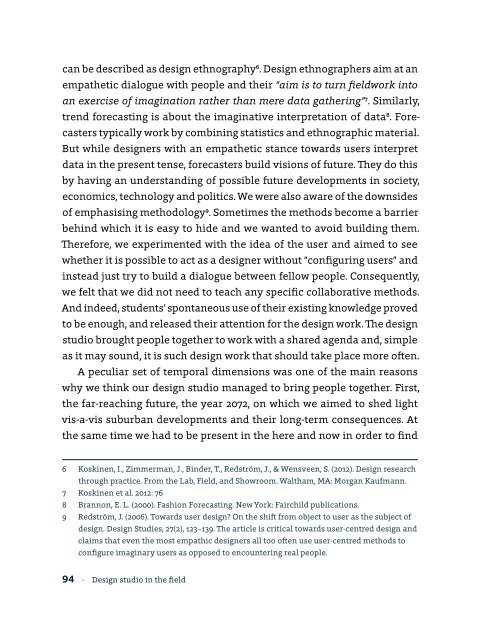Designing for wellbeing
Designing for wellbeing
Designing for wellbeing
Create successful ePaper yourself
Turn your PDF publications into a flip-book with our unique Google optimized e-Paper software.
can be described as design ethnography 6 . Design ethnographers aim at an<br />
empathetic dialogue with people and their “aim is to turn fieldwork into<br />
an exercise of imagination rather than mere data gathering” 7 . Similarly,<br />
trend <strong>for</strong>ecasting is about the imaginative interpretation of data 8 . Forecasters<br />
typically work by combining statistics and ethnographic material.<br />
But while designers with an empathetic stance towards users interpret<br />
data in the present tense, <strong>for</strong>ecasters build visions of future. They do this<br />
by having an understanding of possible future developments in society,<br />
economics, technology and politics. We were also aware of the downsides<br />
of emphasising methodology 9 . Sometimes the methods become a barrier<br />
behind which it is easy to hide and we wanted to avoid building them.<br />
There<strong>for</strong>e, we experimented with the idea of the user and aimed to see<br />
whether it is possible to act as a designer without “configuring users” and<br />
instead just try to build a dialogue between fellow people. Consequently,<br />
we felt that we did not need to teach any specific collaborative methods.<br />
And indeed, students’ spontaneous use of their existing knowledge proved<br />
to be enough, and released their attention <strong>for</strong> the design work. The design<br />
studio brought people together to work with a shared agenda and, simple<br />
as it may sound, it is such design work that should take place more often.<br />
A peculiar set of temporal dimensions was one of the main reasons<br />
why we think our design studio managed to bring people together. First,<br />
the far-reaching future, the year 2072, on which we aimed to shed light<br />
vis-a-vis suburban developments and their long-term consequences. At<br />
the same time we had to be present in the here and now in order to find<br />
6 Koskinen, I., Zimmerman, J., Binder, T., Redström, J., & Wensveen, S. (2012). Design research<br />
through practice. From the Lab, Field, and Showroom. Waltham, MA: Morgan Kaufmann.<br />
7 Koskinen et al. 2012: 76<br />
8 Brannon, E. L. (2000). Fashion Forecasting. New York: Fairchild publications.<br />
9 Redström, J. (2006). Towards user design? On the shift from object to user as the subject of<br />
design. Design Studies, 27(2), 123–139. The article is critical towards user-centred design and<br />
claims that even the most empathic designers all too often use user-centred methods to<br />
configure imaginary users as opposed to encountering real people.<br />
94 · Design studio in the field
















